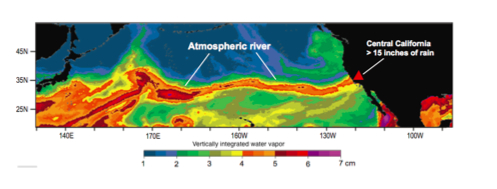New science forecasts include everything except moderation

Two days before Governor Jerry Brown hosts his own conference on “Extreme Climate Risks and California’s Future,” scientists and a smattering of state and local officials spent a rainy Tuesday at Scripps Institution of Oceanography in La Jolla, talking about just that.
It began with calls to keep the funding for statewide climate research. Sacramento legislators may be looking at cutting money to the Public Interest Energy Research (PIER) program in particular, and California Energy Commission vice chair James Boyd told the crowd “all is not well.” He said that research funding is “under assault again” with the weak economy used to question the focus on climate at a time when predictions are becoming more severe.
Our wintertime “atmospheric river” storms known as the “Pineapple Express” will be increasing in frequency and intensity, according to an ongoing investigation by Mike Dettinger, also of Scripps and the U.S. Geological Survey (USGS).

“California’s winter storms are as big as any that strike in the US,” rivaling those in the southeastern “Hurricane Alley” in potential for precipitation, says Dettinger. Funneling data into seven current climate models shows that the most extreme of these events will increase by half or even double in size. “Extreme-season” years in which we would see ten or twenty of these storms also increases by about 50 percent from mid-century on. Think coastal erosion, landslides, power outages, and potentially the largest floods the state has seen.
California heat wave activity is increasing, reported Sasha Gershunov from the Climate Research Division here at Scripps/UCSD. Along California’s coast, both north and south, heat will become more extreme and more frequent, he says, with even the nights staying warmer and becoming more humid (this would appear to run counter to other projections of at least a medium-range “coastal cooling” trend but Gershunov was talking specifically about conditions during heat waves). Gershunov also recapped the “high-confidence” projection of more frequent and more intense droughts for the state, with the southern two-thirds of California even more prone but with the northern end of the state possibly becoming wetter.
Fire danger is increasing dramatically, according to Tony Westerling from UC/Merced. Using a mid-range model for greenhouse gas emissions (one that the world is already on track to exceed), Westerling is showing that the likelihood of intense fire seasons — like the 11 major fires in 1987 — increases 18 times by the end of the century. And until researchers can put the variable of lightning strikes into the climate models — a big factor in the 1987 fire season — the estimate of an 18-fold increase is probably on the low side, says Westerling.
[module align=”left” width=”half” type=”pull-quote”]By 2100, “the whole summer will look like what the ten worst days look like now.”[/module]
UC Berkeley Economist Max Auffhammer cast those heat-and-fire projections against the state’s utilities and their transmission lines. During the increasing number of extremely hot days, natural gas plants could see a “peak supply loss” of about 4 percent, and a drop of one-to-two percent in transmission efficiency on their lines. Under the climate change model that we’re now on track to hit, the Central Valley and the southeast corner of California could see a 50% increase in electricity demand by 2100. By then, “the whole summer will look like what the ten worst days look like now,” said Aufhammer.
Environment and economy specialist Michael Haneman, also of UC Berkeley, says it may help cities and counties to apply the mathematical tools of risk management, like those used by insurance companies, to these extreme events. Los Angeles Department of Water and Power (DWP) commissioner Jonathan Parfrey found “incredibly important information” to take home to the southern California utility. For instance, the DWP was forecasting a decrease in power demand because of increased efficiency — but the forecast he heard yesterday was for a 50% increase. Parfrey would like to hear more. ‘It’s also fascinating to hear that hotter days actually impact even the generation of electricity (as well as demand). It’s something that we have to look at.”
The full agenda for Governor Brown’s conference in San Francisco is available as a PDF download.
